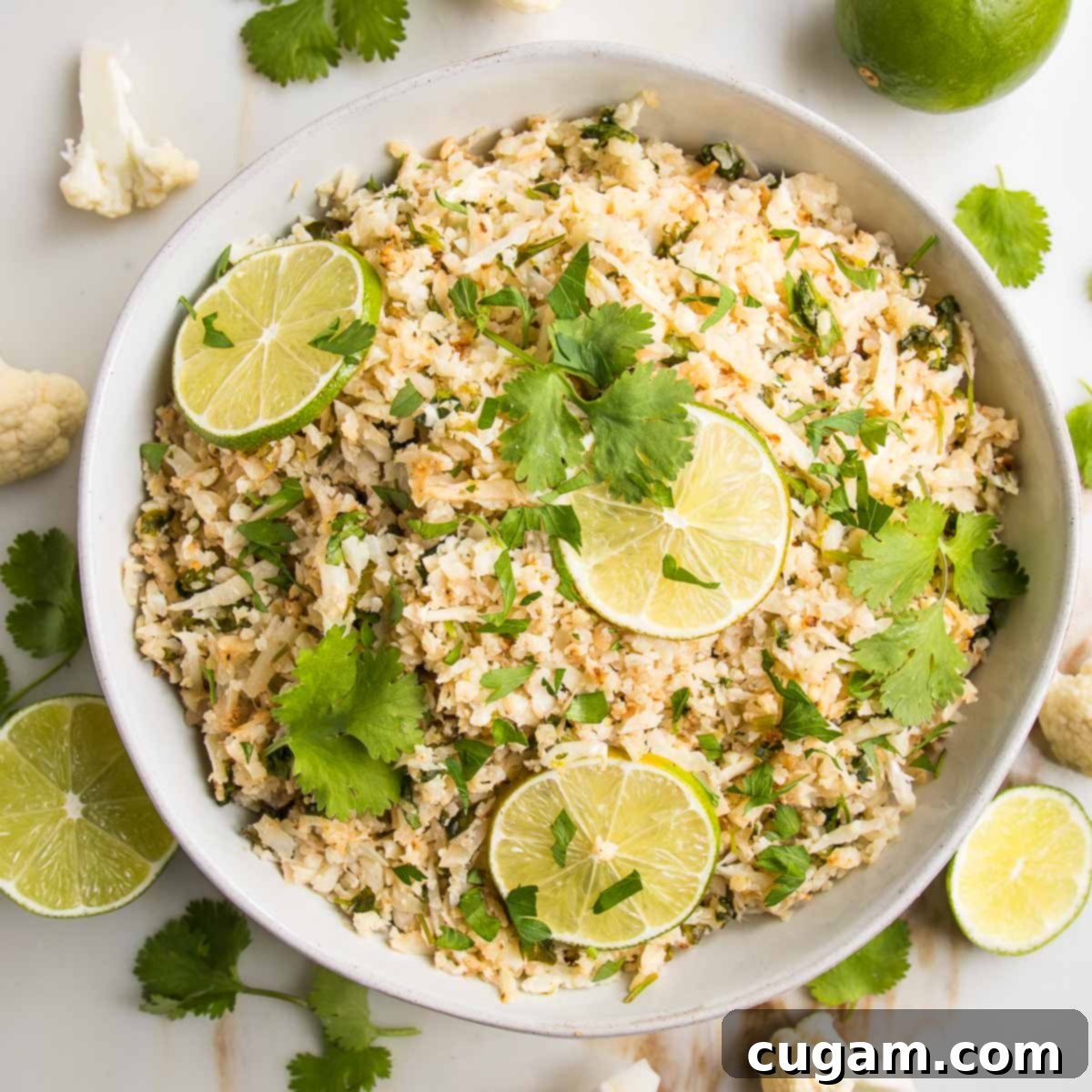Easy 10-Minute Stovetop Cauliflower Rice: Your Ultimate Low-Carb Side Dish
Searching for a quick, healthy, and incredibly versatile side dish that won’t weigh you down? This Simple Stovetop Cauliflower Rice Recipe is a true kitchen hero. Ready in just 10-15 minutes, it serves as an excellent low-carb, grain-free alternative to traditional rice, seamlessly complementing everything from vibrant stir-fries and rich curry dishes to hearty burritos and wholesome grain bowls. It’s not just easy to make; it’s a delicious way to lighten up your meals without sacrificing flavor or satisfaction.
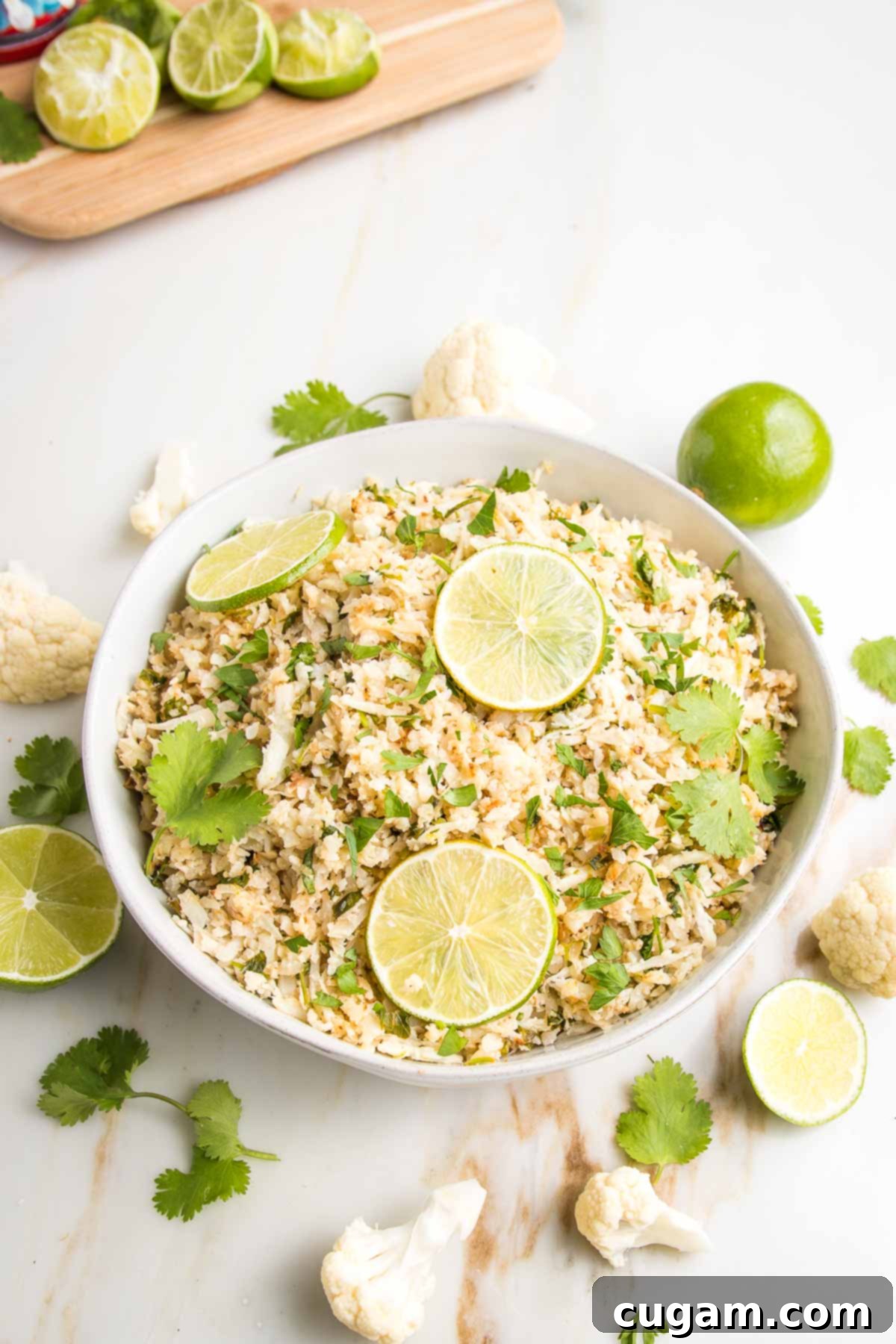
This post has been updated from the original posted on April 23, 2018, to bring you even more helpful tips and delicious insights!
[feast_advanced_jump_to]
In today’s fast-paced world, finding meals that are both nutritious and quick to prepare can be a challenge. This simple stovetop cauliflower rice recipe rises to the occasion, allowing you to get a delicious, wholesome meal on the table in just 15 minutes. It’s remarkably low in calories and carbohydrates, incredibly easy to customize, and pairs beautifully with virtually any main course you can imagine. Whether you’re following a low-carb diet, looking for a gluten-free option, or simply want to boost your vegetable intake, this recipe is a fantastic choice.
Cauliflower rice recipes have become a beloved staple for many, offering the satisfying texture and versatility of regular rice with added health benefits. They are incredibly adaptable, allowing you to infuse them with a variety of flavors. For instance, my Mediterranean Cauli-Rice is bursting with fresh, vibrant tastes, and I also highly recommend this flavorful oven-roasted Mexican cauliflower rice, which is made on a single sheet pan for super easy cleanup – perfect for busy weeknights!
Looking for more Healthy Passover Recipes? Discover new and exciting ways to enjoy Kosher for Passover dishes while maintaining a balanced diet with delicious Vegetarian and Vegan Recipes for Passover.
What is Cauliflower Rice? A Healthy Grain-Free Alternative
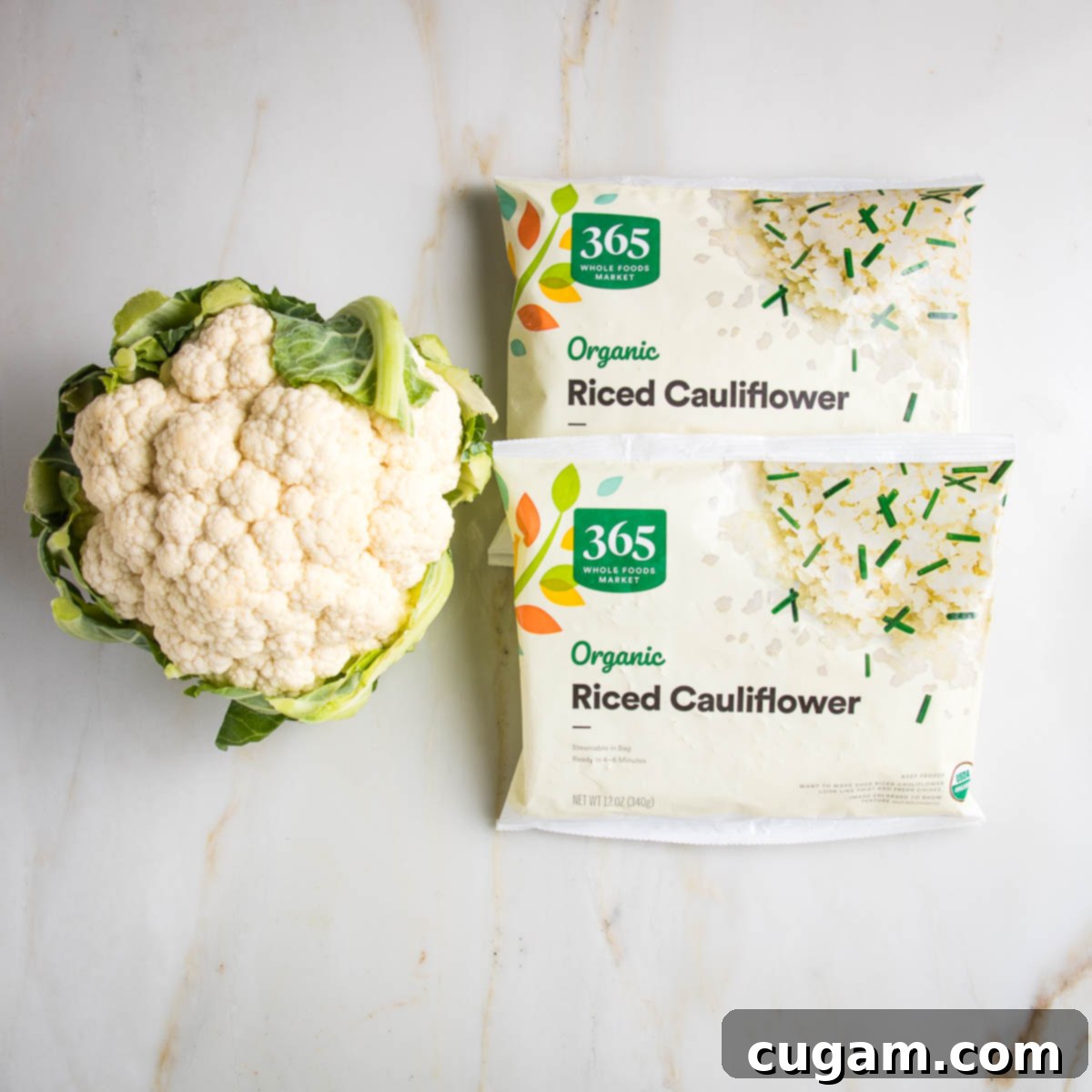
Cauliflower rice is a popular low-carb, grain-free alternative to traditional rice, made by finely chopping or grating cauliflower florets into small, grain-like pieces. Its neutral flavor makes it an incredibly versatile base that easily absorbs the seasonings and sauces of any dish. It’s not just a trend; it’s a smart way to enjoy a satisfying side while significantly reducing your carbohydrate intake and boosting your vegetable consumption.
- Ease of Preparation: This ingenious alternative transforms cauliflower into rice-like grains, making it incredibly easy to incorporate into your diet. It’s a fantastic way to lighten up heavier meals and boost your nutrient intake effortlessly.
- DIY vs. Store-Bought: You have the option to buy a whole head of cauliflower and transform it yourself using a food processor (using the shredding disc) or a simple box grater. Alternatively, for ultimate convenience, you can purchase pre-riced cauliflower in the produce or freezer section of most grocery stores.
- Nutritional Powerhouse: Cauliflower is an exceptional cruciferous vegetable, renowned for its impressive nutritional profile. It’s packed with dietary fiber, essential Vitamins C, K, and B6, and potassium. The difference in caloric intake is significant: one cup of cauliflower rice contains approximately 25 calories, compared to about 218 calories in a cup of cooked brown rice. This means you can enjoy a generous serving and feel fully satisfied without the heavy, uncomfortably full feeling often associated with traditional grains. It’s also naturally gluten-free and suitable for keto, paleo, and vegan diets.
- Yield and Equivalency: A single large head of cauliflower typically yields about 6 cups of fresh cauli-rice. This is roughly equivalent to two 12-oz packages (or 24 oz total) of frozen riced cauliflower. In many recipes, one head of cauliflower can serve as a suitable substitute for about 4 cups of cooked grain rice.
Essential Ingredients & Creative Substitutions for Your Cauliflower Rice
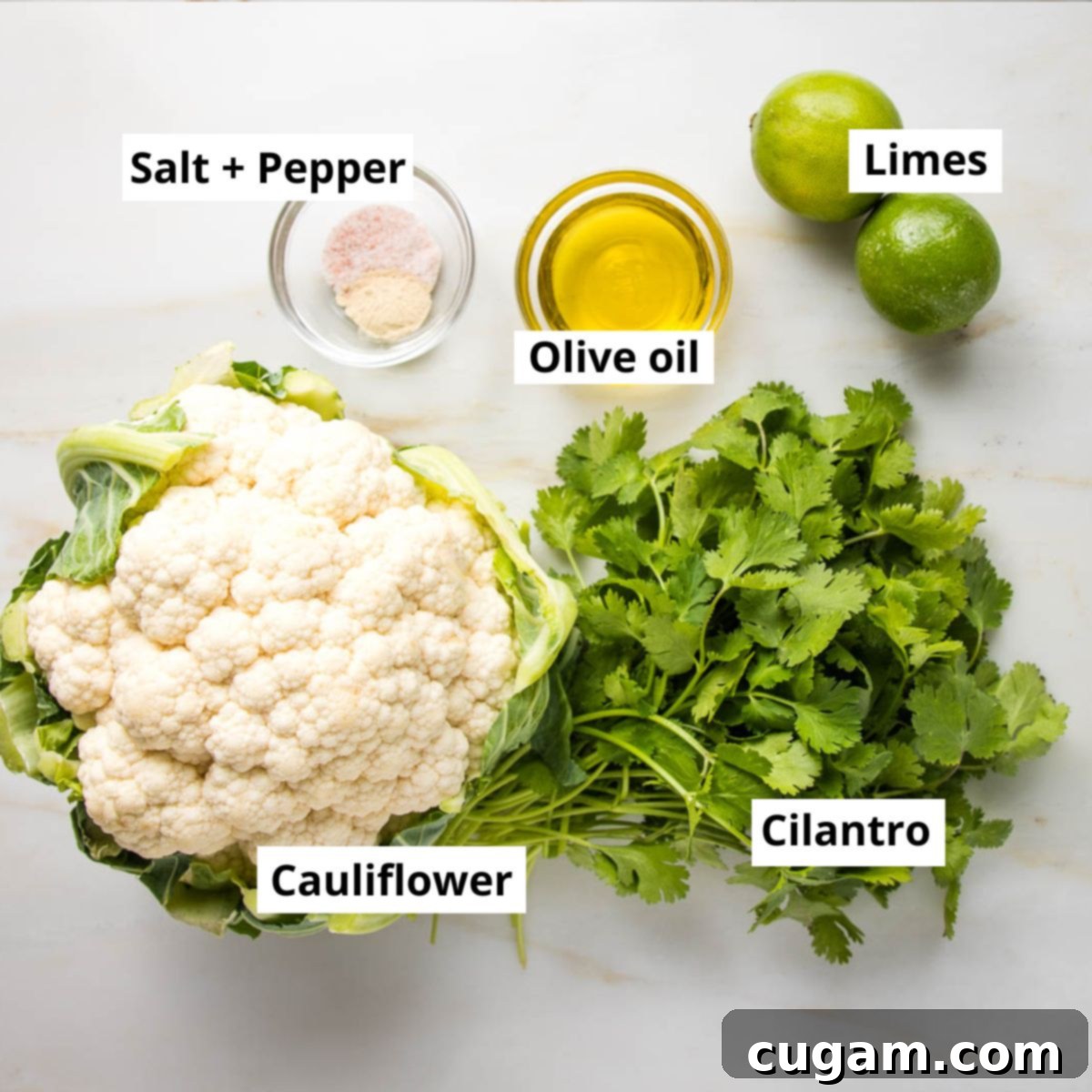
The beauty of this simple cauliflower rice recipe lies in its adaptability. While a few core ingredients create a wonderfully fresh and flavorful base, there’s ample room to customize and substitute to suit your taste preferences or dietary needs.
- Cauliflower: The star of the show! Feel free to experiment by using riced broccoli, or even a combination of riced cauliflower and broccoli for a slightly different flavor and nutrient boost. For more ideas on pairing this versatile vegetable, check out my post on what to serve with cauliflower.
- Fresh Herbs: Cilantro lends a bright, herbaceous note that’s perfect for many cuisines. However, if cilantro isn’t your favorite, or you simply want to change things up, consider fresh parsley for a milder, earthy flavor, oregano for a Mediterranean twist, or basil and thyme for an aromatic touch. Fresh mint would be incredibly refreshing, especially in a summer dish. A combination of any of these herbs can also create a unique and delightful profile.
- Olive Oil: Extra virgin olive oil adds a lovely richness and helps the cauliflower rice achieve a slightly crispy texture. For a no-oil, lighter, and equally healthy side dish, substitute the olive oil with vegetable broth. Cooking with broth will also infuse the cauliflower with deeper flavor, making it taste more like a savory cauliflower rice pilaf.
- Citrus: Fresh lime zest and juice are crucial for a bright, tangy finish. Remember to wash your limes thoroughly before zesting. If you don’t have limes, lemon offers a similar zesty kick, while orange zest and juice can provide a subtle sweetness, perfect for an Asian-inspired variation.
- Seasoning: Keep it delightfully simple with sea salt and freshly ground white or black pepper. White pepper offers a milder, more subtle heat and won’t stand out visually in lighter dishes. Beyond the basics, this is where you can truly make the recipe your own! Consider grating a little fresh garlic or ginger directly into the pan for incredible flavor without needing extra oil or salt. See the “Cauliflower Rice Variations” section below for more exciting flavor profiles!
How to Make Rice from Cauliflower (DIY Guide)
Making your own cauliflower rice from a whole head of cauliflower is a straightforward process that offers the freshest results and can be more economical than buying pre-riced packages. Here’s how you do it:
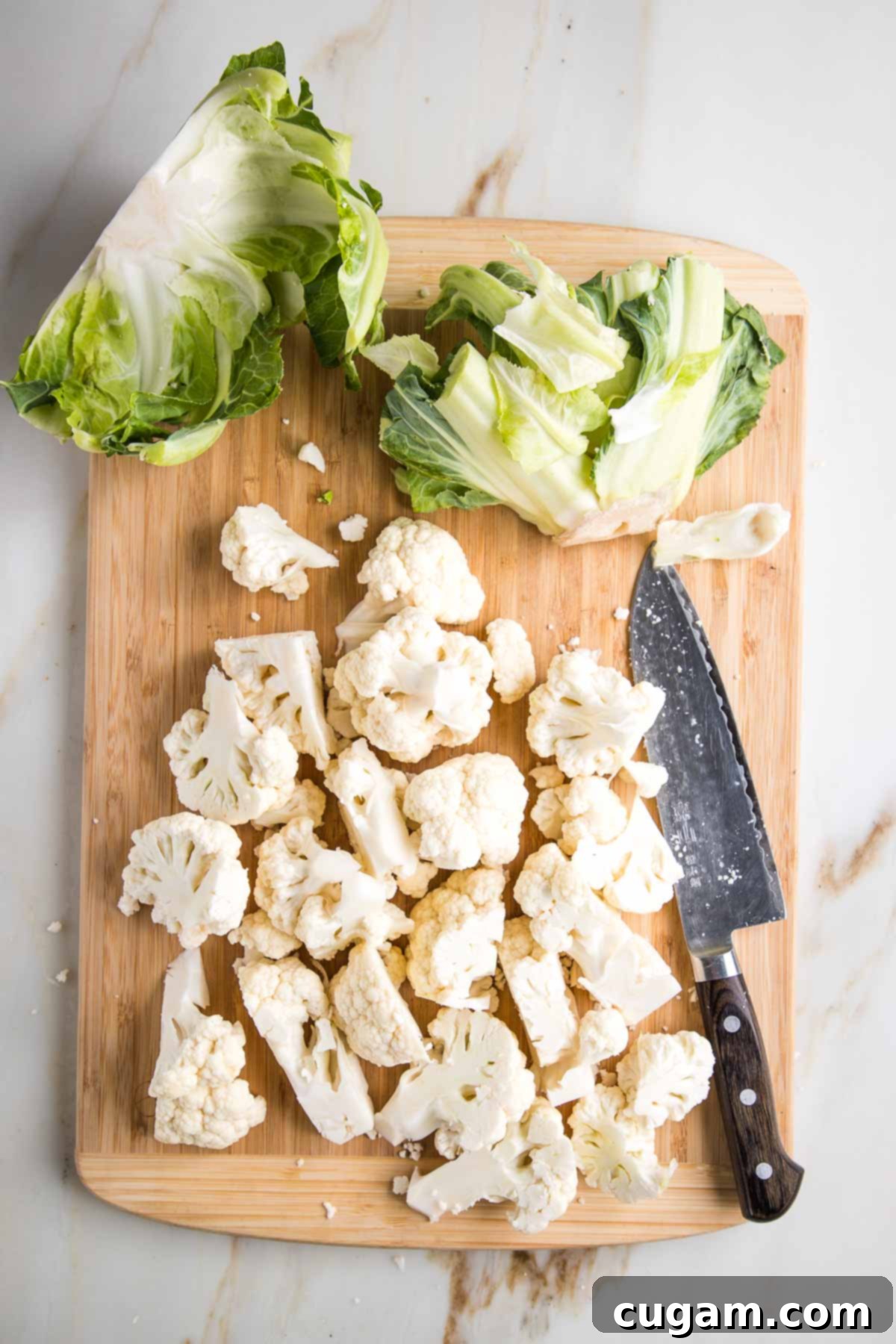
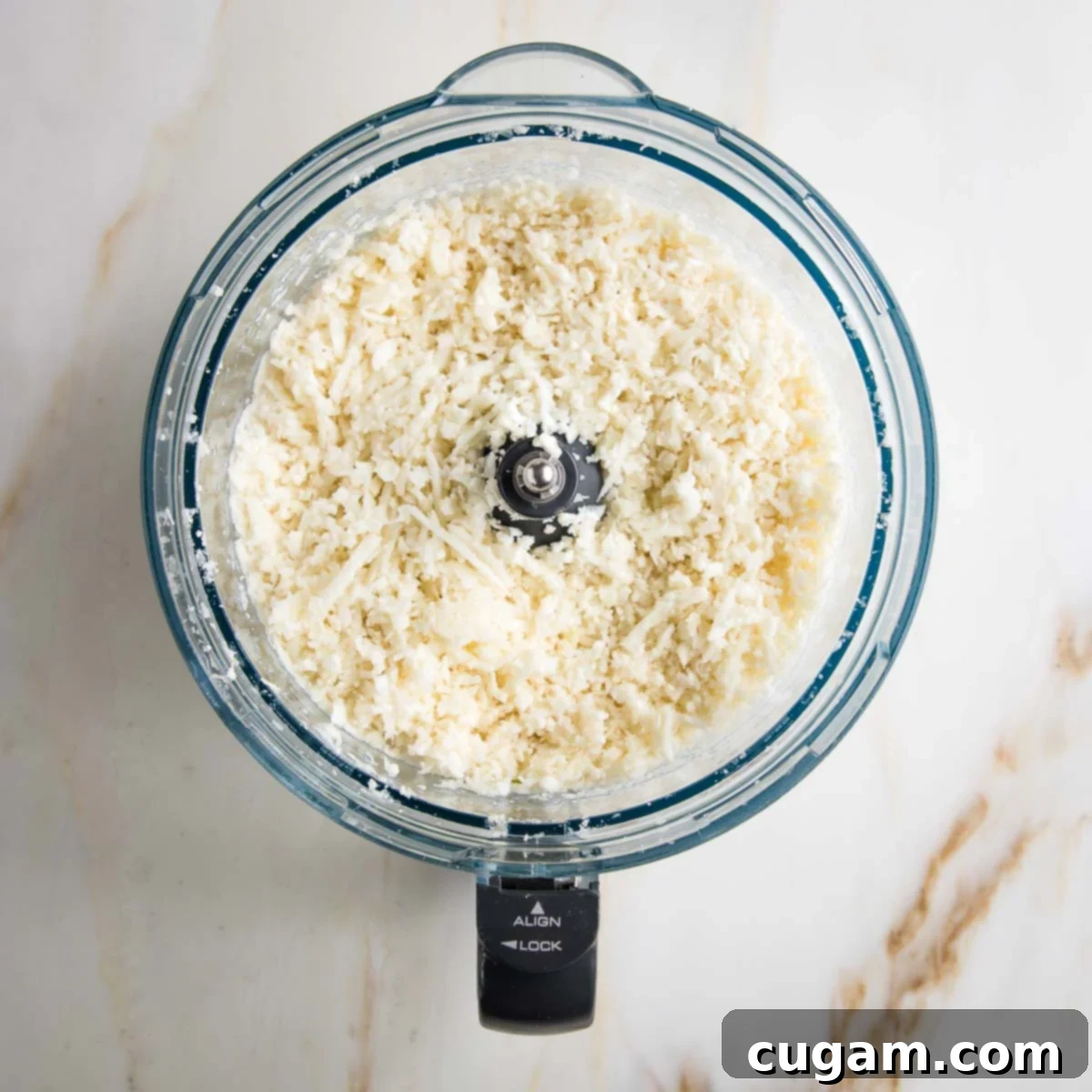
- Prepare the Cauliflower: Start by washing your head of cauliflower thoroughly. Trim off the tough green leaves and the core. Roughly chop the cauliflower into florets of a manageable size – aim for pieces that will fit easily into the feed tube of your food processor or are easy to handle for grating.
- Using a Food Processor: Attach the shredding disc (not the chopping blade) to your food processor. Feed the florets through the chute, applying gentle pressure. The disc will quickly transform them into tiny, uniform pieces that perfectly resemble rice. Be careful not to over-process, as this can turn the cauliflower into a mushy paste rather than distinct grains. Work in batches if necessary to avoid overcrowding.
- Storage (if not using immediately): Freshly riced cauliflower can be stored in an airtight container in the refrigerator for up to 5-7 days or frozen for up to 3 months.
No Food Processor? No Problem! Manual Ricing Methods
Don’t own a food processor? No worries! You can still easily make delicious cauliflower rice with a few simple kitchen tools:
- Using a Box Grater: This is the most common manual method. After trimming the cauliflower and cutting it into manageable halves or quarters, simply use the side of a box grater (the large holes work best) to shred the florets. Hold the cauliflower firmly and grate it over a large bowl or cutting board. This method requires a bit more elbow grease but yields excellent results.
- Buying Pre-Riced Cauliflower: For ultimate convenience and to save time, you can always purchase cauliflower that is already riced. Look for it in two forms:
- Fresh: Found in the refrigerated produce section of most grocery stores, typically in sealed bags or containers.
- Frozen: Available in the freezer aisle. Frozen riced cauliflower is a fantastic option as it requires no defrosting and cooks up beautifully directly from the freezer. It’s also great for stocking up!
Step-by-Step: Crafting Your Perfect Stovetop Cauliflower Rice
Follow these simple steps to prepare a flavorful batch of cauliflower rice on your stovetop in minutes. This method ensures a tender yet slightly al dente texture that’s never mushy.
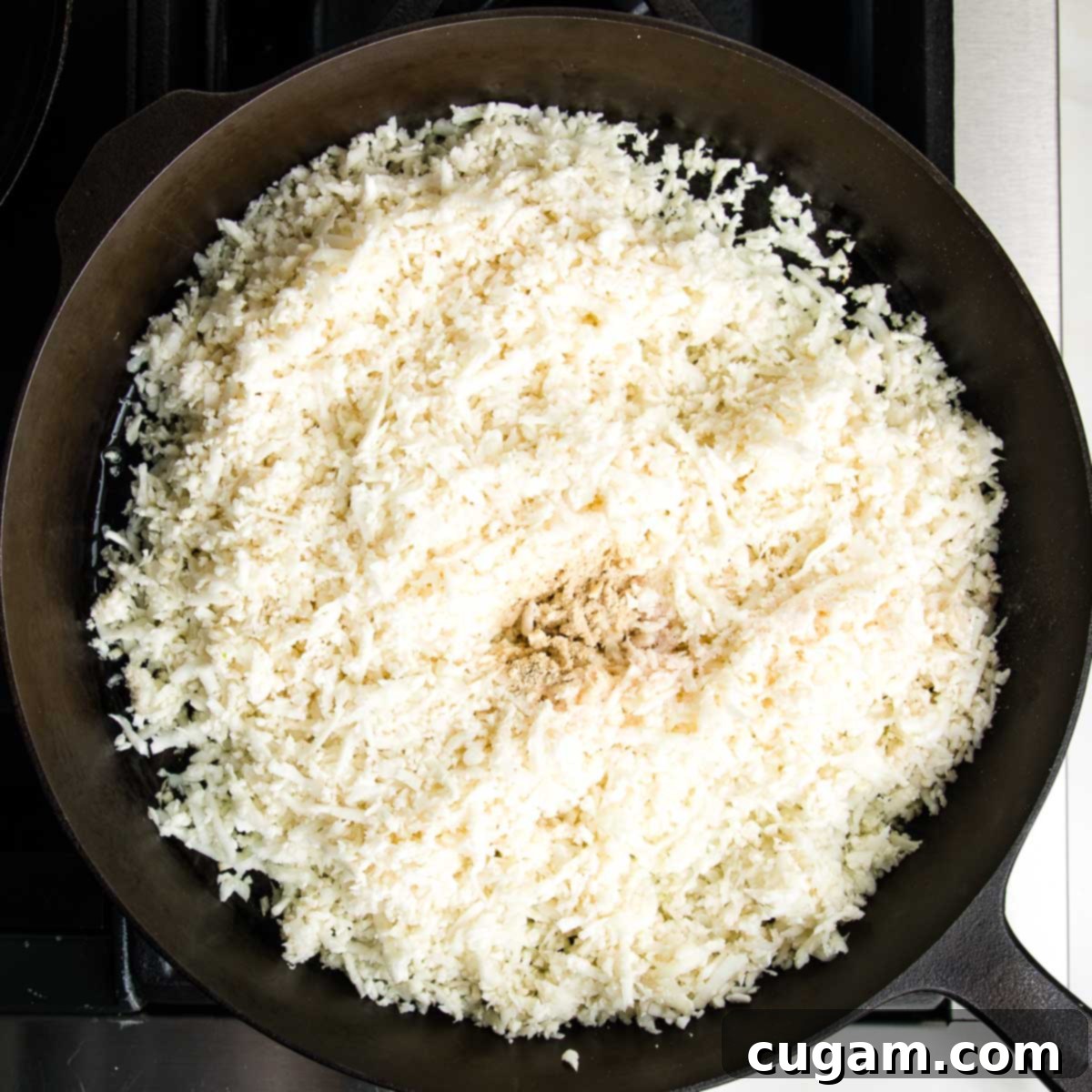
Step 1: Sauté the Cauliflower Rice. Heat a large, heavy skillet (cast iron works beautifully for even heat) over medium-high heat. Add your chosen olive oil or vegetable broth and swirl to coat the pan. Immediately add the riced cauliflower, along with a generous pinch of salt and pepper. Use tongs or a spatula to stir the cauliflower frequently. Cook until the cauliflower begins to soften and slightly tender-crisp. This typically takes 3-5 minutes for fresh cauliflower and about 2-3 minutes for frozen (no need to defrost!). Avoid overcooking, as this can lead to a watery or mushy texture. The goal is a light, fluffy rice-like consistency.
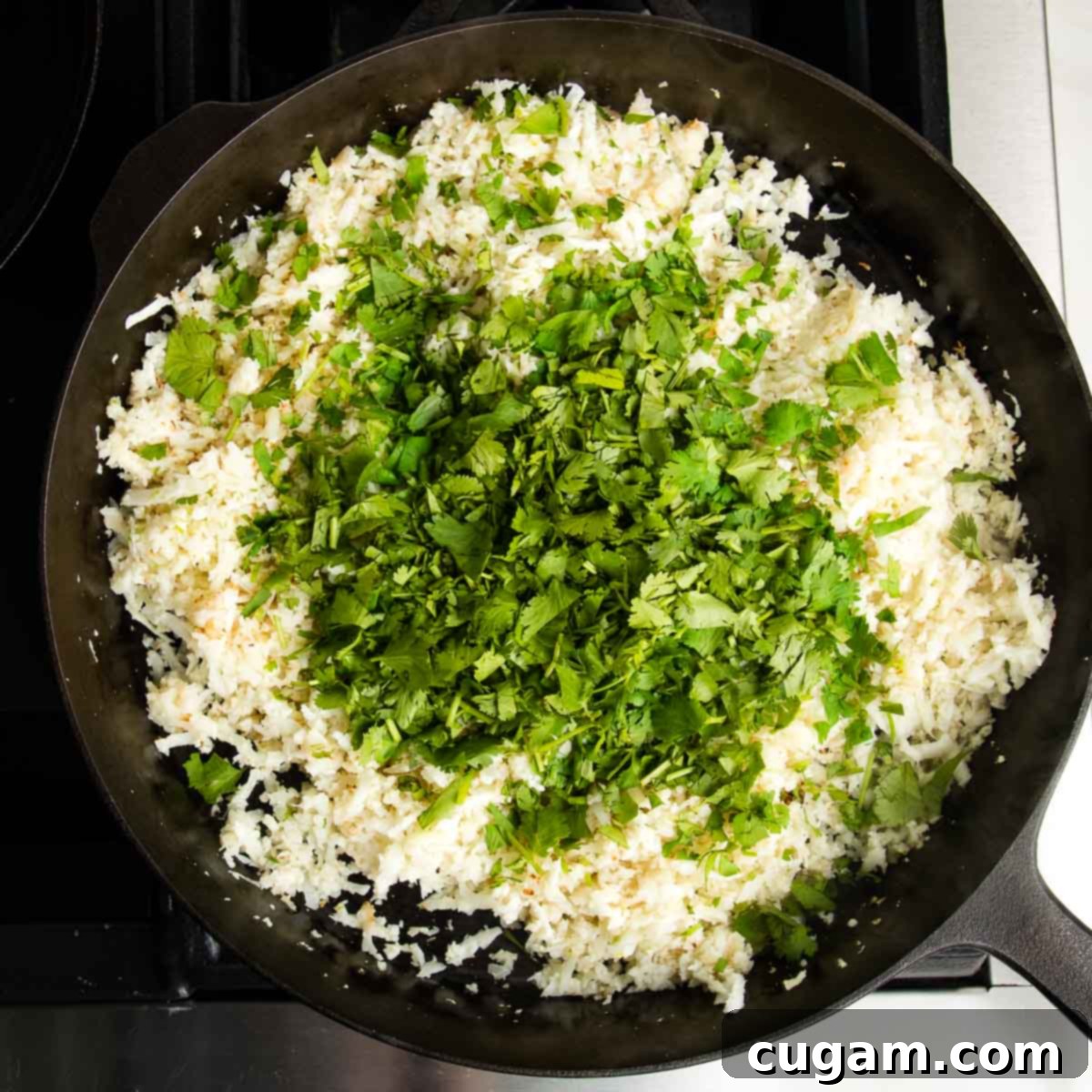
Step 2: Incorporate Fresh Herbs and Citrus Zest. Once the cauliflower has softened, reduce the heat slightly to medium. Add your finely chopped fresh herbs (like cilantro) and the zest from your limes directly into the pan. This is where a Microplane zester really shines, allowing you to get all that aromatic oil from the citrus peel without any bitter pith.
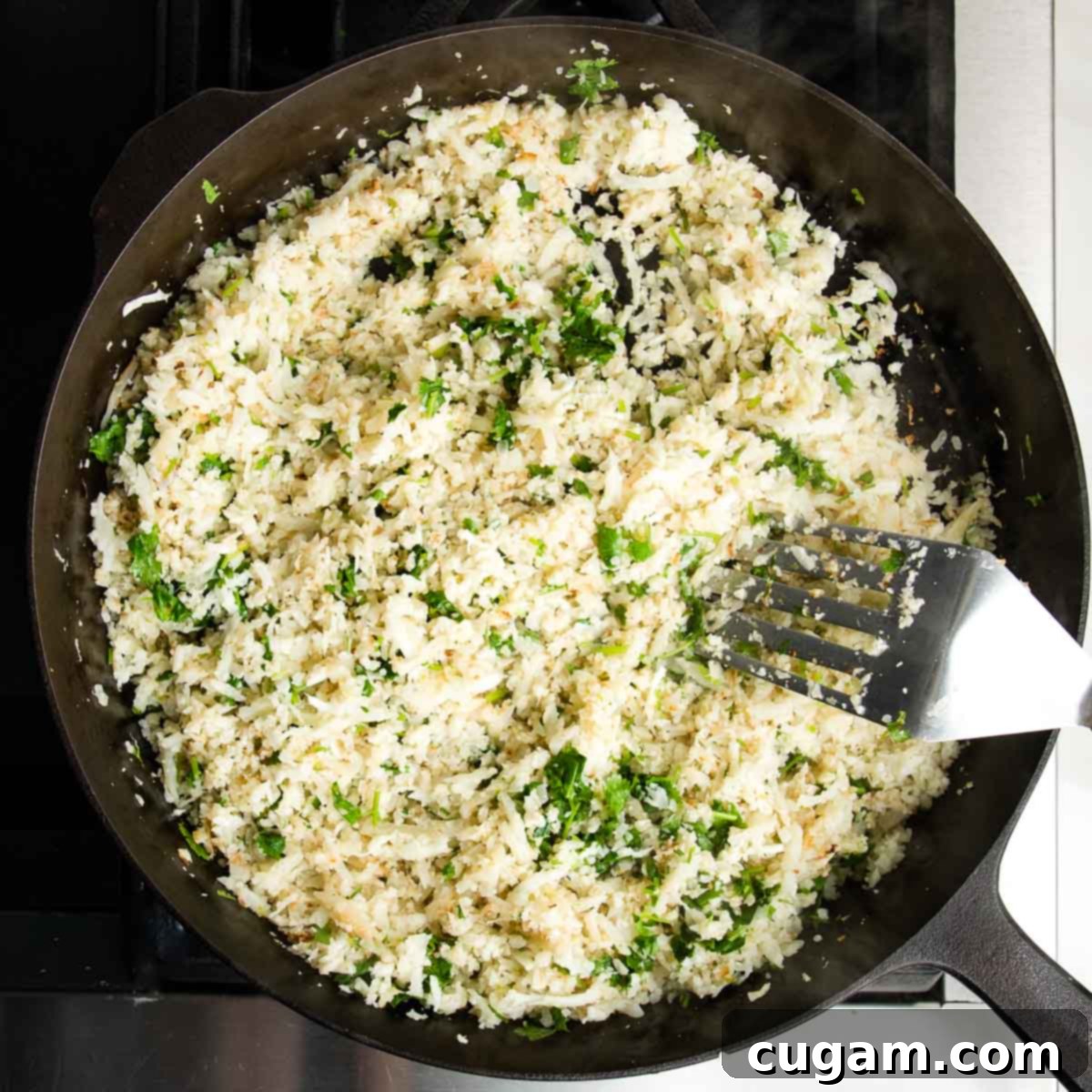
Step 3: Finish Cooking and Season. Continue to cook and stir the cauliflower rice for about 2-3 more minutes. During this time, the fresh herbs will slightly wilt, and their flavors will meld beautifully with the cauliflower. The rice should be tender but still have a pleasant bite. Finally, remove the skillet from the heat and generously squeeze the fresh lime juice over the entire pan. Toss everything together one last time. Taste for seasoning, adding more salt, pepper, or lime juice if you desire a brighter, tangier flavor. Serve immediately while warm, or at room temperature.

Serve hot as a perfect side dish, or allow it to cool and enjoy it at room temperature. This simple preparation method ensures maximum flavor and minimal fuss!
Cauliflower Rice Variations: Endless Flavor Possibilities
The plain base of stovetop cauliflower rice is a blank canvas, eager to take on an array of flavors. Here are some exciting variations to keep your meals fresh and interesting:
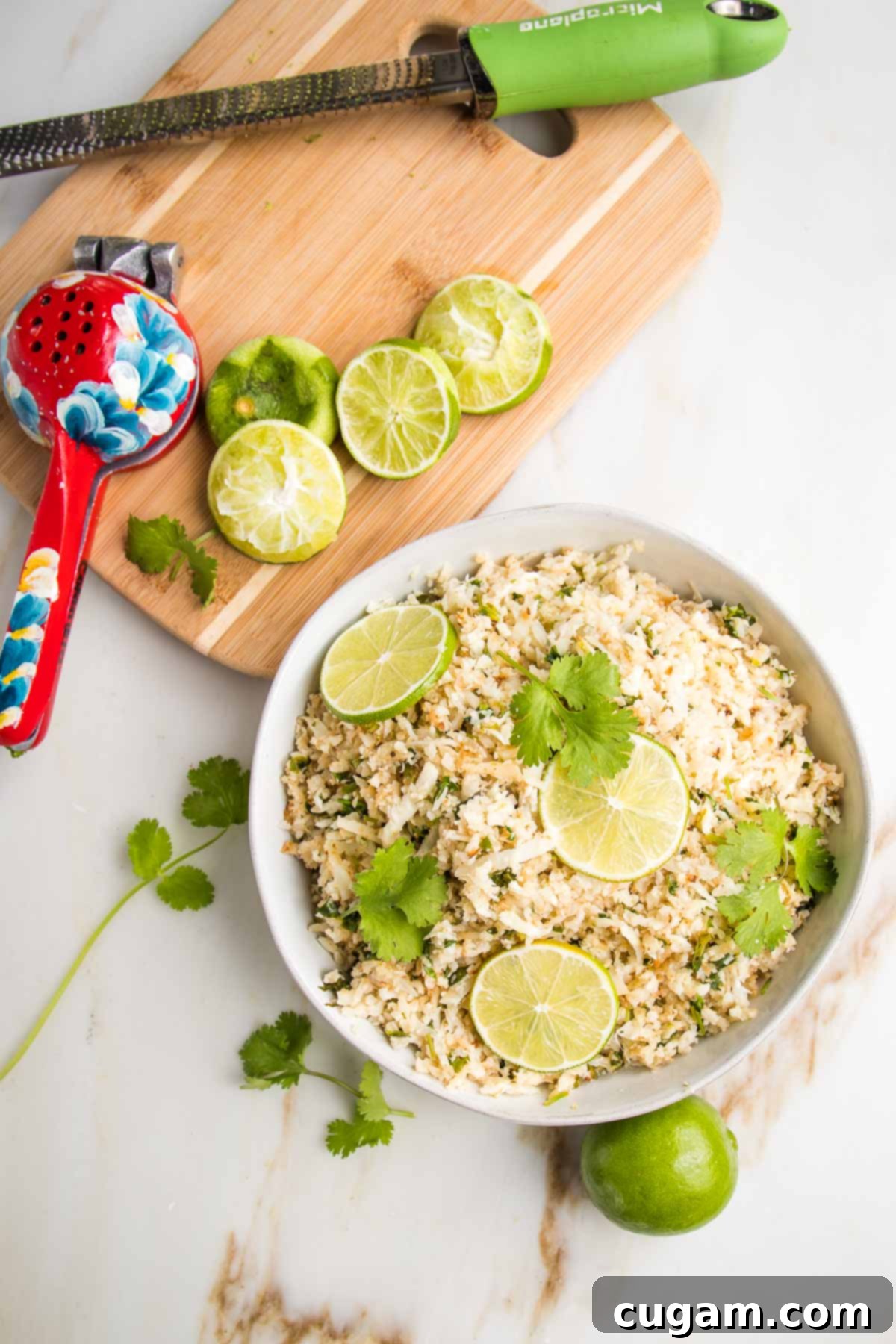
- Mexican Cauliflower Rice: To create a vibrant Mexican-inspired dish, you can either follow my oven-baked Sheet Pan Mexican Cauliflower Rice Recipe for a hands-off approach, or simply add a medley of spices to this basic stovetop recipe. Incorporate cumin, chili powder, a hint of tomato paste for depth, minced jalapeños for a kick, and dried oregano. For extra texture and nutrition, consider adding diced bell peppers, sliced green onions, sautéed mushrooms, and black beans. A squeeze of extra lime juice at the end will truly bring out the festive flavors.
- Asian Cauliflower Rice: Transform your cauliflower rice with an umami-rich Asian twist. Swap the olive oil for aromatic toasted sesame oil. Skip the lime and instead add a splash of tamari (or soy sauce for a non-gluten-free option), freshly grated ginger, and minced garlic. A tablespoon of sesame seeds will add a lovely crunch and nutty flavor. For a more substantial meal, stir in snow peas, thinly sliced bell peppers, shelled edamame, and cubes of crispy baked tofu.
- Mediterranean Cauliflower Rice: For a taste of the Mediterranean, substitute lime with fresh lemon zest and plenty of fresh lemon juice. Stir in juicy halved cherry tomatoes, toasted pine nuts, briny Kalamata olives, and a generous sprinkle of dried oregano. These ingredients will create a refreshing and savory flavor profile. For a comprehensive guide, refer to my dedicated Mediterranean cauliflower rice recipe, which outlines all the best ingredients for this easy low-carb side dish.
- Vegan Main Dish Cauliflower Rice: Elevate this side dish to a complete vegan meal by boosting its protein content. Stir in cooked lentils, black beans, chickpeas, or a mix of your favorite nuts and seeds like almonds, cashews, or pumpkin seeds. Another fantastic idea is to fold in seasoned oven-baked tofu cubes. This simple addition transforms it into a hearty, delicious, and plant-based dinner or lunch.
- Cauliflower Rice Pilaf Recipe: A cauliflower rice pilaf typically involves cooking the cauliflower rice in a flavorful liquid, such as vegetable broth (or chicken stock if not vegan/vegetarian). This method infuses the “rice” with a deeper, more savory taste. Often, a pilaf recipe will also incorporate a rich fat like butter, ghee, or coconut oil, which contributes to a luxurious, creamy texture and a more indulgent flavor. You can also add finely diced carrots, celery, and onions (a classic mirepoix) for an even more traditional pilaf feel.
Debra’s Pro Tips for Perfect Cauliflower Rice Every Time
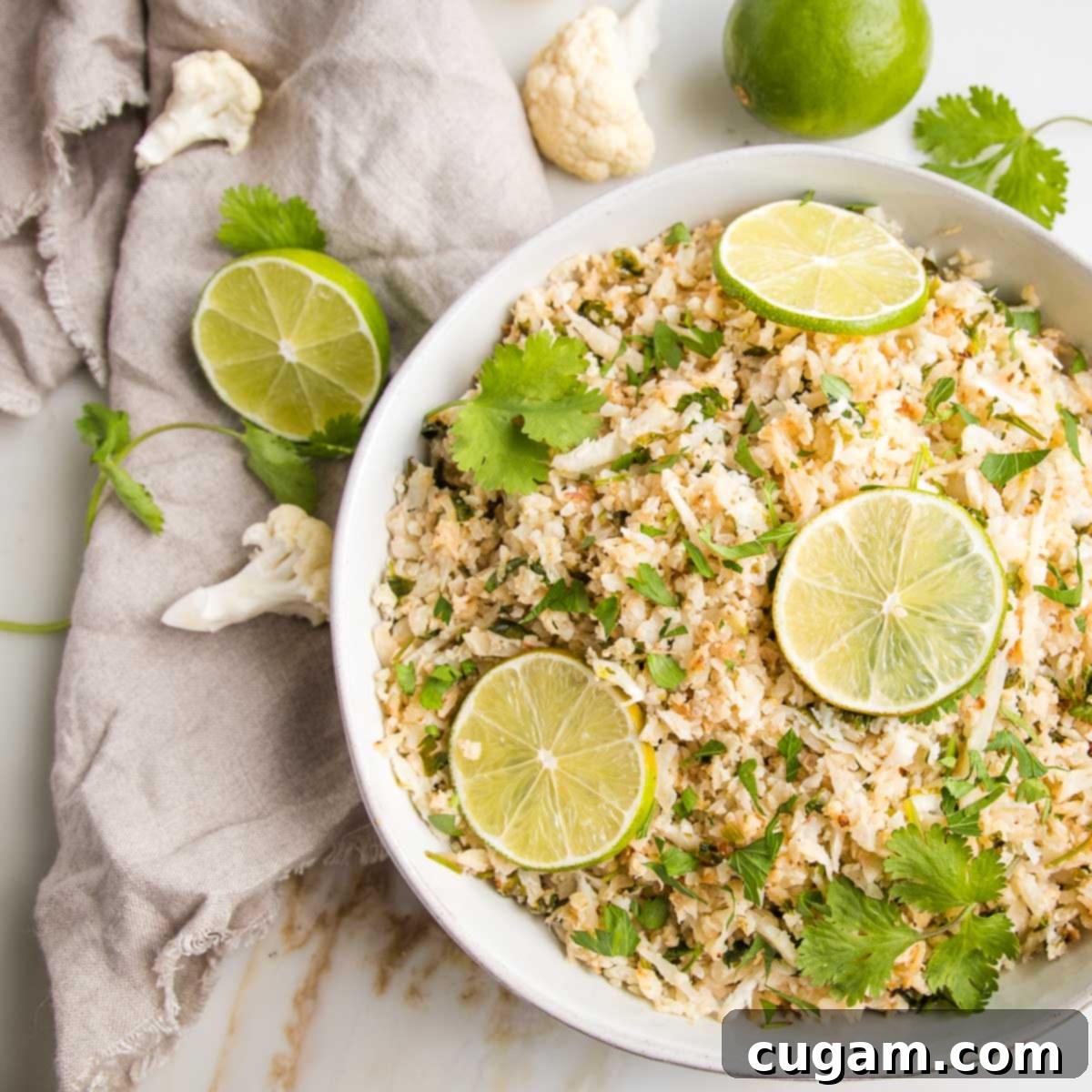
- Cook Once, Eat Twice (or More!): Maximize your efforts by making a double batch of this healthy cauliflower rice recipe. Having leftovers on hand is a game-changer for meal prep. Easily add it to mason jar salads for work lunches, serve it as a quick side for another stir-fry dinner, incorporate it into your Taco Tuesday buffet, or even mix it into a Sunday brunch frittata for added vegetables and texture. It’s incredibly versatile for repurposing!
- Spice It Up for a Kick: If you love a little heat, don’t hesitate to add some pizazz! A sprinkle of crushed red pepper flakes, a few thinly sliced jalapeños (remove seeds for less heat), or a dash of your favorite hot sauce during the last few minutes of cooking will give this simple side dish an exciting fiery edge.
- Prevent Sogginess: The key to great cauliflower rice is to prevent it from becoming watery or mushy. Ensure your skillet is hot and avoid overcrowding the pan. Cook in batches if necessary, allowing enough space for the cauliflower to sauté and evaporate moisture rather than steam. A quick cooking time on medium-high heat is ideal.
- Save Money by DIYing: Making your own cauli-rice from a whole head of cauliflower using a food processor or a box grater is often significantly cheaper than buying pre-packaged versions. It’s a small effort that can lead to big savings over time.
- Save Time with Pre-Riced Options: If time is of the essence, take advantage of commercially available riced cauliflower. You can find fresh options in the produce section of your local grocery store, or opt for frozen cauliflower rice, which is widely available at big box stores and most supermarket chains. Frozen varieties are excellent for convenience and can be cooked directly from the freezer.
- Don’t Waste the Core and Stems: While you’re preparing your cauliflower florets, don’t discard the core and tougher stem pieces! These can be roasted, added to soups, or even blended into smoothies for an extra nutritional boost. Minimal waste, maximum nutrition.
Meal Prep & Storage: Enjoy Cauliflower Rice All Week
This stovetop cauliflower rice is an ideal candidate for meal prepping, ensuring you have healthy and delicious options ready to go throughout the week. Properly storing and reheating will keep it tasting great.
- SERVE: This versatile dish is delicious served warm, fresh off the stove, or at room temperature. It makes an excellent healthy side dish for almost any meal. To transform it into a light yet satisfying vegan dinner or lunch, simply stir in some plant-based protein like cooked beans, lentils, or a sprinkle of toasted nuts and seeds.
- PREP AHEAD: Absolutely! This recipe is perfect for preparing in advance. Cook a large batch and store it for quick meals. When you’re ready to reheat, you have a couple of excellent options:
- Oven Method: Spread the cauliflower rice evenly on a sheet pan. Reheat in a preheated 350-degree F (175-degree C) oven for about 10-15 minutes, or until thoroughly heated through and slightly crispy.
- Stovetop Method: Place a heavy skillet (like cast iron) over medium heat with a tiny bit of olive oil or broth. Add the cauliflower rice and stir-fry gently until it’s heated through and revived, usually 5-7 minutes.
- STORE: Allow any leftover cauliflower rice to cool completely before storing. Transfer it to an airtight container and keep it in the refrigerator for up to a week. Follow the reheating instructions above for best results.
- FREEZE: For longer storage, freeze completely cooled, cooked cauliflower rice in freezer-safe containers or bags for up to 3 months. Thaw overnight in the fridge or cook directly from frozen in a hot skillet, breaking up any clumps as it heats.
Explore More Healthy Cauliflower Recipes
Cauliflower is a truly magnificent vegetable, offering incredible versatility and health benefits far beyond just rice. If you’ve enjoyed this recipe, you’ll love exploring these other delicious and nutritious ways to prepare cauliflower:
- Whole Roasted Cauliflower Recipe
- Raw Cauliflower Salad with Lime
- Cauliflower Kugel Recipe
- Roasted Cauliflower Hummus Recipe
We hope this guide inspires you to make cauliflower rice a regular, healthy, and flavorful addition to your meals. It’s truly a game-changer for quick, low-carb cooking!
Did you know commenting and rating recipes is one of the best ways to support your favorite food bloggers? If you made this recipe, please consider a five-star rating below and leave a comment sharing your experience. Also, please share your photos on Instagram by tagging me @dkhealthcoach and using the hashtag #debraklein – I’d love to see your delicious creations!
📖 Recipe

Simple Stovetop Cauliflower Rice
Rate this Recipe
Pin Recipe
Equipment
-
Citrus Squeezers
-
Microplane
-
Cast iron skillet
-
Box Grater
-
Food Processor
Ingredients
- 2 Tablespoons extra virgin olive oil
- 1 large head cauliflower*
- ¾ cup finely chopped fresh cilantro
- ½ teaspoon sea salt
- ½ teaspoon white pepper
- 2 limes zested and juiced
Instructions
-
Prepare Cauliflower Rice: If using a whole head of cauliflower, trim the leaves and core, then cut into florets. Use the shredding disc of your food processor to process the florets into tiny, rice-like pieces. Alternatively, use the large holes of a box grater to shred the cauliflower. If using frozen riced cauliflower, no defrosting is needed.
-
Sauté and Season: Heat a heavy, large skillet over medium-high heat. Swirl in the olive oil (or vegetable broth for oil-free). Add the riced cauliflower, sea salt, and white pepper. Using tongs or a spatula, toss the rice continually until it begins to soften and is tender-crisp. This typically takes about 5 minutes for raw cauliflower or 3 minutes for frozen. Then, stir in the finely chopped cilantro and continue tossing for about 3 more minutes, allowing the herbs to wilt slightly.
-
Finish with Citrus: Remove the skillet from heat. Use a zester to add the lime zest directly over the pan, then squeeze the fresh juice from both limes over the cauliflower rice. Toss everything thoroughly to combine. Taste for seasoning, adding more salt, pepper, or lime juice as needed to achieve your desired flavor balance.
-
Serve and Store: Serve the cauliflower rice immediately while hot, or enjoy it at room temperature. Leftover rice can be stored in an airtight container in the fridge for up to 1 week. Reheat gently on the stovetop over medium heat or in a 300-degree F (150-degree C) oven for about 15 minutes until heated through.
Video
Notes
OPTIONAL FLAVORFUL ADDITIONS: Elevate your cauliflower rice with crushed red pepper flakes, minced jalapeños, grated fresh ginger or garlic, additional fresh herbs (like parsley or mint), a pinch of cumin, chili powder, a dash of tamari (for an Asian twist), or some briny olives.
OPTIONAL PLANT-BASED PROTEIN: To turn this side dish into a complete meal, consider adding cooked lentils, beans, a mix of nuts or seeds. Oven-baked tofu cubes also make a great, delicious, and satisfying addition.
This recipe serves 6 as a side dish. If you add lentils, beans, nuts, or seeds, it will comfortably serve 4 as a hearty vegan main dish.
Nutrition
Note
The nutrition calculations were done using online tools. To obtain the most accurate representation of the nutritional information in any given recipe, you should calculate the nutritional information with the actual ingredients you used. You are ultimately responsible for ensuring that any nutritional information is accurate, complete and useful.
